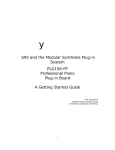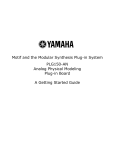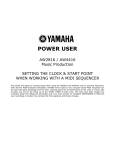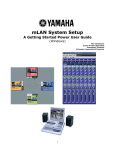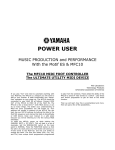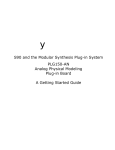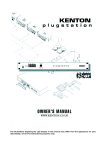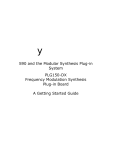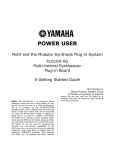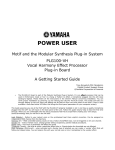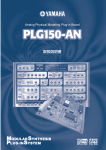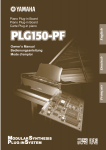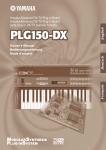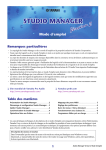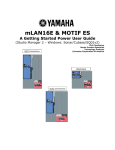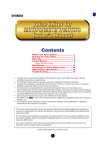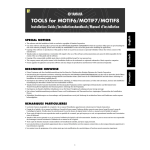Download Yamaha PLG150-PF User's Manual
Transcript
y Motif and the Modular Synthesis Plug-in System PLG150-PF Professional Piano Plug-in Board A Getting Started Guide Phil Clendeninn Digital Product Support Group ©Yamaha Corporation of America 1 certain parameters available for real time tweaks. For example, if the original programmer applied a Control Delay or an LFO based effect, then you will be able to control how it works. But you will not be able to change the pre-assigned Board effect. As we will see in this article, this is not a problem because you can assign Motif effects to any Board sound and store it as one of your own PLG USER Voices. yMotif & PLG150-PF PLG150-Pf Piano Plug-in Board The PLG150-PF is a sample playback based single part plug-in board. It is based on the same AWM2 technology that is used in the Motif wave ROM. It features 16MB of sounds exclusively in the piano category (acoustic grand pianos, electric pianos: Rhodes, Wurlitzer and DX7 type, Clavinet, Harpsicord, electro-acoustic (CP80-type). These sounds are painstakingly sampled and meticulously voiced by our experts. Classic sounds of the ‘60’s and ‘70’s are of particular interest. A large gathering of antique classics were assembled for the sampling sessions. Inspiration for voicing the classic sounds found here include Richard Tee, Donny Hathaway, Bob James, David Foster, Joe Sample, Josef Zawinul, Emuir Deodato and others. Sounds were programmed to mimic the classic recordings where these sounds were immortalized. Much detail was paid so that these sounds work in context of music. The acoustic grand pianos (many of them) are stretched tuned adding animation to the sound when used in the context of a group. Checking Installation For installation instructions please follow the Owner’s Manual pages 282-283. Check to make sure your board or boards are properly installed. The Orange connector is slot 1, the yellow connector is slot 2 and the Green connector is slot 3. A PLG150series board can occupy any slot.1 The boards should always be installed with the Motif off – the boot up routine will check the plug in slots and automatically, if it detects a board it will load 64 Preset sounds for that board. (The VL board is the exception. It has actually 3 PRESET banks of 64 that it will load when a VL board is detected – one for Aftertouch play, one for Velocity play and one for Breath Control). Here’s how to verify your board: On the Motif: Press [UTILITY]/[F6] PLG to check the status screen which will identify all the PLG boards found and their slot location: The PF board differs from the other PLG150 series boards in two ways. First, it is based on samples (the AN, DX and VL are all non-sample based technologies). Second, it does not have an “Expert” editor or a USER RAM bank for “from scratch” waves. It sounds funny to have to explain this but for a sample playback board to have its own “from scratch” bank would require too much RAM. The ‘pure’ synth boards like the AN, DX and VL in comparison use very little RAM to store entire banks of Voice data. The DX, for example, has a bank of 32 sounds equal to about 4KB (that kilobytes!) of data. Four kilobytes of sample data is really nothing at all. Samples require mucho megabytes of data! Therefore the sounds on the PLG150PF are largely presets that you can tweak via OFFSETS. Part of what you are paying for, however, is the excellent VOICE programming. Although the PF board has a similar architecture to the Motif, 4-element AWM2 sample playback, you do not have the same degree of editing that you would with a Motif VOICE. Rather than being able to program “from scratch”, you recall a mostly finished AWM2 Voice that has The “Expand” parameter will be active only when you have 2 or more PLG150 series boards of the same type installed and polyphony expansion is possible. A second PLG150-PF can give you a maximum of 128 notes of piano board polyphony in Expand poly mode. A third PLG150 can give you 192 notes total for piano board. Because the System is modular, this polyphony does not take away from the 62-note polyphony of the mothership host (S30 / S80 / CS6x / CS6R / Motif6-7-8)Nor does it contribute to a pool of notes – they are completely separate. You, of course, can use multiple boards as individuals, thus increasing how many Parts for which you will have PLG150-PF Voices available. 1 HINT: Find a consistent slot layout for your boards and stick with it. When making bulk files that reload your custom sounds (AN, DX, and VL only), it matters which slot the board is found in. 2 To select banks: From the main Voice screen press the F2 BANK button, then use the wheel or the INC/YES, DEC/NO buttons to change to the various banks. When ready to try the Voices in that bank Press F1 PLAY. There are three banks you should concern yourself with when you have the PLG150-PF board in a Modular Synthesis Plug-in System host (like the Motif). They are the PLG PRE1, PLG’1’USR*, and 032/000. * number refers to slot The sounds When you boot up your Motif, one of the queries it does is to the PLG slots, “Now checking Plug-in boards…”. If it finds a PLG150-PF board in one of the slots it will load from ROM a bank of 64 Voices that will address the PLG150-PF. This bank is referred to as the PLG PRE1 bank (PLUG-IN PRESET1). The Presets will find the PLG150-PF board. The bank will always be PLG PRE1 no matter which slot you place the board. The aforementioned 128 “BOARD” Voices will be found in a bank called 032/000. In the main Voice screen above, the P1-P prefix denotes that the PF board is in PLUG-IN SLOT 1 (P1)2 and this is a Preset bank (P). These are 64 sounds are programmed integrating them with Motif parameters, controllers and effects. They are made with great care to play well and give you a remarkable set of piano category sounds. In addition to the PLG PRE1 bank of 64 Motif provides a PLG USR bank with 64 blank locations for you to create your own variations. These remain a part of the Motif memory after power down. They are made from the 128 Board Voices (raw data) provided on the PLG150PF board. Press F2 Bank from the main Voice Screen and select the 032/000 bank Board Voices have yet to be integrated with Motif parameters, controllers or effects. It may be a bit much to call them “raw” data because they are already tweaked to a “ready-to-play” state – but they do not have Motif Effects applied yet. There are 128 sounds resident here. Select bank 032/000 then press F1 PLAY. Obviously, 64 of these have already been programmed for the PLG PRE 1 bank. But there are 64 more sounds waiting for you to tweak and store as PLG USR sounds. • Listed The PLG150-PF sounds are divided into two categories: Finished “PLUG-IN” VOICES (like the PLG PRE1 and the PLG USR Voices you will make). These sounds are Motif level Voices – meaning they are sounds that have the source waveforms on the PLG150-PF but they have been integrated with Motif parameters, controllers, and effects. This is opposed to the “BOARD” Voices bank 032/000, which are like the “raw material” that you use to build finished Motif Plug-in Voices. 2 If your PLG150-PF is in slot 2 your screen will read P2-P, slot 3 will read P3-P. 3 below are the 128 Voices. reserves 64 USER locations PLG150 series board. for each The PLG_USR bank (PLG1USR in our example slot 1) will allow you to create and store 64 sounds based on the data on the PLG150-PF board. This Voice data will remain in memory after power down. And will be available as long as the PLG150-PF board has been detected and is in the slot. What is a Plug-in Voice and what is a Board Voice? The PLG_USR bank is initially a blank Motif bank. It awaits your variations (64) of the PLG150-PF data. The voice data on the PLG-PF board are called the Board Voices (032/000). Instead of using ROM samples from the host, the PLG-PF Voices point to sample data that is resident on the PLG-PF board. The Voice data contained on the PLG150-PF is based on specially sampled data – same AWM2 technology as the internal voices. Plug-In Voices are Board Voices that have been integrated with Motif parameters, controllers and effects. (64 PLG PRE and 64 PLG USR) Notice that the Bank is called P1-B. The P1 is the slot, PLUG-IN slot 1. The “B” denotes Board Voice. When you press EDIT, like most edit areas of Motif, there are two levels the COMMON level (reached via the dedicated button) and the Element level (reached via the Track 1 button). • • • The PF board has several banks of sounds as follows: The numbers represent MSB/LSB for bank select – (MSB and LSB Bank Select numbers are used to facilitate remote changes from a device like a sequencer and are used in the Motif’s Song and Pattern MIXING setup. More on that later). Press EDIT Touch the Track 1 button to select Element level programming Press F1 OSC/ SF1 Wave This is the screen where the Motif Voice targets the PLG-PF Board Voice waveform. The PLG150-PF sound is recalled here but you cannot “get at” the individual elements. In the above screen shot, the Piano+Choir sound (which is listed as a 3element sound) is recalled here as a combined waveform. You cannot get at the individual Elements (piano and 2 choir) to select new ones – the way you would with an internal AWM2 Voice. You will be able to adjust the relative volumes of the 3 elements through OFFSET parameters that are provided. Additionally, you can go to the COMMON level and add Motif controller sets and Effects. When you are ready to store your work it will be saved to one of 64 PLG_USR bank locations. The Motif PLG_USR = 64 blank locations (Saved in ALL, ALL VOICE and VOICE EDITOR type Files). When used in a MIX look for the MSB/LSB numbers, and Pu1, Pu2, or Pu3 according to which slot, as follows: If PLG150-PF is in slot 1: 63/24 Pu1 If PLG150-PF is in slot 2: 63/25 Pu2 If PLG150-PF is in slot 3: 63/26 Pu3 What this means is: if your PLG150-PF board is in slot number 1, then the PLG1USR bank will be addressed by bank numbers 63/24. PLG1USR = the 64 empty locations reserved for the PLG150-PF detected in slot 1. PLG1USR is Pu1. If your 4 PLG150-PF is in slot 2, then the PLG2USR bank will be addressed by bank numbers 63/25, etc. XG Banks: *Other banks are for XG extension. These begin with MSB/LSB 080/xxx and 096/xxx. These are PF-XG extensions for use in XG/GM systems. These are basically the preset board Voices rearranged into various banks for use in XG products that can also access sounds on the PLG150 series boards. They are the same 128 sounds found in 32/00 just rearranged for GM/XG category use. You can ignore these when using the board in the Motif. PLGPRE1 bank = the 64 Preset PLUG-IN VOICES loaded on detection of the PLG150-PF; (These are loaded automatically on power up). When used in a MIX, look for MSB/LSB numbers, and “Pp1” below the Part, as follows: If PLG150-PF is in slot 1: 63/70 Pp1 If PLG150-PF is in slot 2: 63/73 Pp1 If PLG150-PF is in slot 3: 63/76 Pp1 How the PLG150-PF Works Let’s go through the steps of tweaking a PLG150-PF sound. You cannot build a sound “from scratch”, you must start with the programming provided by the original programmer of this data. The samples have been looped and meticulously mapped and the elements have been built. Effects and/or EQ has already been applied to make these sounds “ready-to-play”.3 The chip set on the PLG150-PF allows limited access to specific effects. In other words, if a sound is routed through an effect that effect is available for you to tweak – but its assignment is fixed. You cannot reprogram the effect assignment on the board. That assignment is fixed – you can control it but you cannot re-assign it. You can add the Motif effects Reverb, Chorus, and Dual Insertion Effects in addition to those that may be provided on with the PLG150-PF programming. Consult the documentation that accompanies the PLG150-PF for the type of Insertion Effect that is active (if any) on each of the provided sounds. For example, Voice #17: AmbiGrand is a 2 element Voice with a “Cross Delay” Insertion Effect assigned. Or check out #90: WurliAmp, a classic Wurlitzer sound in an “Amp Simulator”. #68: Sample is an electric piano in a Rotary Speaker. These are effects that are on the PLG150-PF board itself and will be active in a MIX when you select the PLG150-PF for a PART. This is not a Motif effect – it refers to the effect processing available on the PLG150-PF board itself. What this means is that if your PLG150-PF board is in slot 1, then the PLG PRE1 bank will be bank 63/70. If you select that MSB/LSB in your MIXER you will be in touch with the Plug-in Preset1 bank (Pp1). The Preset Bank for the PLG150-PF will always be PLG PRE1 no matter which slot. 032/000 = 128 preset Board Voices. These are the resident sounds of the PLG150-PF. Use these waveforms to build finished Motif Plug-in Voices. You can either build Motif level Voices and store them to one of 64 PLG USR locations or you can access these sounds directly through a SONG or PATTERN MIX. If you call these up directly through a MIX, they will still use the effect (if any) that is preprogrammed on the PLG150-PF Board Voice, but they will not have any Motif Voice level effects assignments. You can apply the System Effects (Rev, Chorus) and Variation effect of the MIX. You can apply controller and other parameters via the PART parameters of the MIX – this lets you customize any Board Voice for each “local” Song or Pattern. If you use them directly in a MIX you will see the MSB/LSB 032/000 and PB below the Part. If PLG150-PF is in slot 1: 032/000 PB If PLG150-PF is in slot 2: 032/000 PB If PLG150-PF is in slot 3: 032/000 PB When addressing Plug-in Board Voices directly in a MIX you must be careful when you have multiple boards of different technologies. Voice parameters must match the technology of the board in the slot. If you point PLG150-PF parameters to a PLG150-AN you will get a “TYPE MISMATCH” message and you will get no sound. Let’s take a closer look so that this is clear. We are going to do a step-by-step tweak of the “Wah Clav” Board Voice and turn it into a finished Motif Plug-in Voice. 3 Of course, you wouldn’t want to buy a PLG board and have to do all that work yourself. 5 • Start in VOICE mode Select the PLG Slot with your PLG150PF (our example will refer to slot 1) Press F2 Bank and select bank 032/000 • • Place F1 PLAY Select Voice H13: --Wah Clav • • effects etc.) if you have a pedal capable of sending Sustain as a continuous stream of data. The Board also has its own two-band tuneable EQ. PAGE right with the cursor arrow. Like the Motif itself, the PLG150-PF board can have up to 4 Elements to a Voice (see the PLG150PF Owner’s Manual for listings of Voices). Although this is fixed (preset) you do have an offset for each Element so that you can change the relative volumes between elements. This is a Board Voice (P1-B)4. Play it and you will see that a wah-wah effect is already active (Auto-Wah). I selected this Voice to show a specific point: Certain of the Board Voices on the PLG150-PF already have effects programmed on the board – the assignment is fixed. You can tweak them via controller offsets (as we will see). Press EDIT • Press COMMON – this selects the upper • level of editing (see below). • As you can see from the asterisks (***) (means parameter is not available) the Wah-Clav is a 2-element Voice. AC1 or “Assignable Control 1” is set to do Element Level on EL1 and EL2. Press the TRACK 1 button – in this case it selects the ELEMENT level of edit mode (see below). The REV and CHORUS processor can only be used if it is activated already. For most Voices you will use the Motif’s REVERB and CHORUS processors. • • F1 OSC/ SF1 Wave – this screen is where the Board Voice is assigned. The Motif parameters that will be stored in a USER VOICE will be applied to this waveform. F4 opens the door to the NATIVE parameters: those “native” to the board. “INS LFO FRQ” translates to INSERT EFFECT Low Frequency Oscillator Frequency. This will offset the SPEED of the wah-wah, in this example. “INS LFO DPT” translates to INSERT EFFECT LFO Depth. This will offset the AMOUNT of wah-wah Filter sweep depth. “INS DRY/WET”. This will offset the balance between dry signal and the effect. This will effectively allow you to turn the wah-wah effect on and off by offsetting the preprogrammed value toward DRY. “PF Mode” deals with the PLG150-PF board’s ability to respond to SUSTAIN as a continuous controller (for half-pedaling 4 The 1 in P1 refers to the SLOT number. If your board is in slot 2 it will be P2-B. 6 “INSERT OFFSET”: In each Board Voice the programmer activated a specific parameter that could be offset. In this one it will set the initial level of the filter controlling the wah-wah. Those parameters that are grayed out (***) are unavailable in this particular Voice, but you may see them active in other preset Board Voices that have effects active that can use them as OFFSETS. It is in this manner that you have access to the effect processor that the original programmer selected for this Board Voice. Check the Owner’s Manual (page 24-25) for information on which Board Voices have Insertion Effects active and for which Insertion Effect Parameters are available for that algorithm (30-32). If, for example, you want to defeat the built-in wah-wah (AUTO-WAH), you could (using the WET/DRY OFFSET). Then you could program your own using the Motif’s powerful, fully editable, DUAL INSERTION EFFECTS – which are, of course, also available to be applied to the PLG150-PF data. The other OFFSETs you see listed refer to other specific effects, for example the CLIP CURVE is a function of the Guitar Amp Simulator, available on the “WurliAmp” sound. In the above two “before-and-after” screens the AS1(16) and AS2(17) are the per Voice programmable Assignable knobs. AS1 is assigned to control the Send amount to the Motif Chorus, while the AS2 is assigned to control the DYN: COMPRESSOR we selected for INS EFF 2. AS2 is setting the Compressors Threshold level. Other Motif level parameters you can assign to the Board Voice: You can assign the Modulation Wheel MW to control Filter Cutoff, Pitch Modulation, Filter Modulation and Amplitude Modulation: Aftertouch AT can be assigned to control Pitch Bend and Filter Cutoff, as well as Pitch Mod, Filter Mod and Amplitude Mod: You can select an Assignable Controller AC Source and have it effect Filter Cutoff, Pitch Mod, Filter Mod and Amplitude Mod: To add Motif level Effects: • • Press the COMMON button Press F6 Effects/ SF1 Connect to apply Motif effects. The Dual Insertion effect is available (in series or parallel), as is the Motif Reverb and Chorus. Above a Dynamic Compressor was selected for INSERT 2. Of course, the Motif Arpeggiator can be applied to the PLG Voice like any other Motif Voice. Be sure to explore the Arpeggiator Note Limit and Velocity Limit parameters and the Play Effects. The Play FX can give the arpeggio some swing or multiply (double/half) the time): 7 You can assign a prefix so that you can use Category Search properly. Our example is in the Keyboard category, KB, and is a CLAVI: User on ASSIGNING YOUR PLG150 PLUGIN BOARD IN A MIX.] In the MIX our finished “Wah Clav” Voice will be found in the 63/24 (Pu1) PLUG-IN 1 USER Bank. Once you have edited to your satisfaction press STORE. The Motif will automatically point you toward an appropriate location in the PLG USR (Px-U) bank: P1 because our board is in slot 1 and “U” USER. When you set the EFF PART to PARTP1 the Motif level INSERTION EFFECTS for the Plug-in slot Voice will be recalled (The DYN: Compressor) from Voice mode. Remember the wah-wah (AUTO-WAH) effect will always be there – it is on the PLG-PF board. It is the Motif INSERTION effect that is activated here. Note the AS1 and AS2 assignments – they reflect our assignments: the Chorus Send and the Threshold for our selected Dynamic Compressor. Housekeeping When you save as an ALL data file, an ALL VOICE type file or as a VOICE EDITOR type, your PLG_USR Voice data will be saved. Phil Clendeninn Digital Product Support Group ©Yamaha Corporation of America Summary: The Board Voice: --Wah Clav already had a wah-wah built in (so to speak) that effect will be active if you use this sound in a Song Mix or Pattern Mix. The AUTO-WAH is an effect actually on the PLG150-PF board. The Chorus and Compressor (are Motif level effects). The Compressor, being an INSERTION effect, will only be active in a Song Mix or Pattern Mix if you activate the INSERT Effect for the PARTP1 (Plug-In slot).5 The Motif Chorus is available in a MIX as a System effect – all Parts, including the PLG Parts, have a send to the System effects. [To actually place a PLG150 Voice in a MIX you need to select it in the MIXER, then EDIT the Part to assign it a MIDI channel. PLG Parts default to being unassigned in a MIX. This is covered in depth in the Power 5 Be careful to note the difference between PartP1, the PLUG-IN PART, and Part01, the Internal Part. 8








